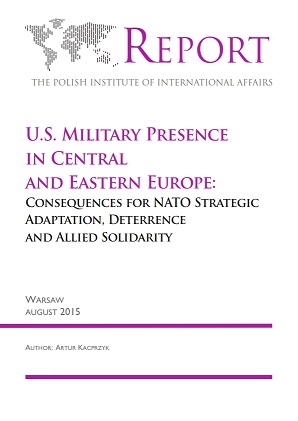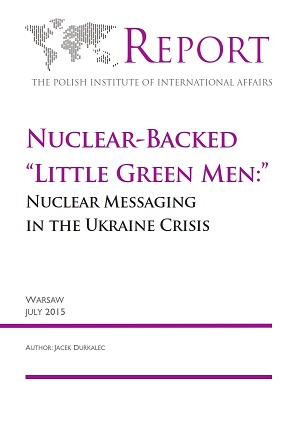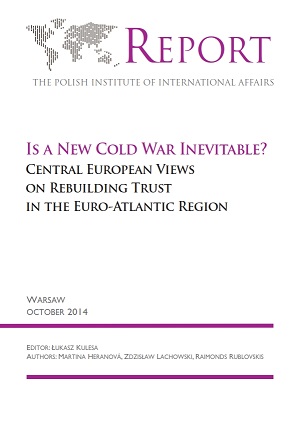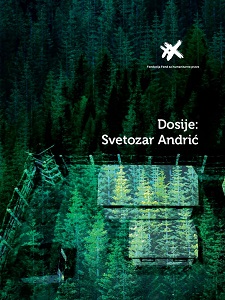
We kindly inform you that, as long as the subject affiliation of our 300.000+ articles is in progress, you might get unsufficient or no results on your third level or second level search. In this case, please broaden your search criteria.


If history teaches us what life is all about, and this is true, then books are testimonies assisting history to show to the next generations where we are and why we have made mistakes instructing us not to stumble twice upon the same obstacle. "Military Secret" is a testimony which came to existence by a concurrence of peculiar circumstances and thanks to my own aspiration to expose entirely and at any cost the position and the role of the top military brass in preservation of an insane regime, alien to both the Serbs and the Montenegrins, at the beginning of the 21st century. Having been drawn into the games of big security services, dragged out of anonymity and motivated by my personal hardships and suffering, but also thanks to good people from the military and the police, I was in a position, amongst other things, owing to kindness of other people, to influence, perhaps, certain currents of history in, judging by everything, now former Yugoslavia. I am aware of the fact that the state is grateful to an individual only while it needs him/her.
More...
Međnarodni položaj Srbije i SR Jugoslavije i dalje je izuzetno složen i nepovoljan. Karakteriše ga: – Ukupno i veliko zaostajanje za promenama do kojih je došlo u svetu i posebno u Evropi, pa čak i pružanje otpora oficijalne i srpske politike (ali ne samo nje) tim promenama. Propuštene su godine i vreme, u kojima je trebalo da se izvrši usklađivanje kako spoljne politike i međunarodnih odnosa Srbije i SRJ, tako i njihovog unutrašnjeg razvoja sa dalekosežnim i temeljnim promenama u Evropi i svetu. – Produženo odsustvo stvarne i pune normalizacije odnosa sa glavnim centrima moći u međunarodnim odnosima. Postojeći kontakti se svode i dalje na razgovore i pregovore u funkciji primene mirovnog paketa sporazuma iz Dejtona. Uz to, ovi kontakti su po pravilu inicirani od strane međunarodne zajednice, odnosno nosioca njenih obaveza proizašlih u Dejtonu, a ne na inicijativu Srbije i SRJ, pa i ne idu dalje od iznuđene "kooperativnosti" srpskojugoslovenske strane.
More...
In the wake of the Ukraine conflict and Russian hostility towards NATO, the United States has proven to be the most resolute and capable Ally of the Central and Eastern European (CEE) states. The U.S. has been striving to provide leadership for the Alliance and invigorate other members to act, while implementing deterrence and reassurance measures on faster and on bigger scale than other countries. U.S. activities in CEE have included persistent rotational presence of small land forces, air and naval deployments to the region, intense training and exercises, unprecedented pre-positioning of heavy armour in the region, and improvements to local infrastructure. The U.S. has acted both bilaterally and multilaterally, as well as within the framework of NATO’s joint Readiness Action Plan (RAP). U.S. actions have been received very warmly among CEE countries, which are concerned about Russia’s behaviour and especially interested in the support and presence of the leading and most powerful member of the Alliance. Nevertheless, for Poland and the Baltic States, the permanent basing of Allied combat forces is a priority. It is necessary to send a strong political signal to Moscow, and prove that there are no second-class security guarantees for new NATO members. The intention is also to deny Russia hopes of achieving a quick victory and presenting the U.S. and the Alliance with a fait accompli. At the very least, small permanent forces would ensure that even a successful attack against CEE states would automatically result in a costly conflict with the U.S. and NATO. At the other end of the scale, bigger deployments would slow down an enemy offensive and buy time for reinforcements to arrive.
More...
Russia’s aggressive actions against Ukraine have exposed the challenge of Moscow’s approach to conflict. The element most highlighted is its use of “hybrid warfare,” epitomised by the so-called “little green men”—Russian soldiers albeit without insignia who played an instrumental role in the annexation of Crimea. These “little green men” were used in conjunction with other hybrid tactics such as the covert engagement of Russian forces on the ground, economic pressure, and an unprecedented disinformation campaign. The hybrid warfare tools were, however, not used alone. The credibility and effectiveness of this hybrid warfare campaign was backed up by Russia’s potential to use its full spectrum of military capabilities, including conventional and nuclear forces. Russian tactics that exploited ambiguity of intent and attribution have been surprising and confusing, and they have created difficulties for NATO, which is determined to effectively address them.
More...
When the idea to invite Central European experts to share their views on overcoming the acute deficit of trust in the relationship between the West and Russia first originated in early 2014, there was still some hope that the Ukraine crisis would not mark the beginning of a new period of confrontation in Europe. With that in mind, PISM asked the authors not only to comment on the state of the relationship with Russia but also to assess to what extent various proposals (including Carnegie’s Euro-Atlantic Security Initiative papers and the 2013 report by U.S., Russian and European experts, “Building Mutual Security in the Euro-Atlantic Region”) regarding military confidence building and arms control dialogue with Russia would advance the security of Central European countries. However, as the situation deteriorated with Russia’s annexation of Crimea and its support for eastern Ukraine separatists, the focus inevitably had to turn from dealing with the symptoms (mutual mistrust) to addressing the root causes of the spat between Russia and the West, which now threatens the very foundations of the European security system. Previous approaches to mending the relationship, such as those focused on finding areas of cooperation based on common interests (e.g., dealing with terrorism or the Iranian nuclear programme), were unlikely to be sufficient.
More...
This book is based on papers presented at the conference. However, it is not a typical publication of academic conference proceedings because the topics are not completely congruent with those of the conference. Some lectures that could not be held due to travel restrictions related to the coronavirus pandemic were submitted as book contributions. In addition, I also wrote a short contribution on the Jewish history of the region, which has been often neglected in previous presentations of the region.The various authors for this volume have been intensively involved with the region in recent years. However, the authors do not only focus on the situation on the ground, but also on the international context of the autonomous administration. The conflict in Syria is no longer just a civil war, but a transnational conflict with important roles played not only by actors such as Russia or the USA, but also Turkey or Iran.Given the transnationality of the conflict and the role of the hegemonic powers, these authors share thoughtful analyses from very different perspectives. It is important to share these diverse views with the world so that the tragic conflict might become more comprehensible. This does not mean, however, that I necessarily advocate each particular position taken by the varied contributors to this book. The intent is to offer you multiple perspectives and certainly not a common narrative.
More...
The events that struck Bosnia at the turn of the millennium - its people slaughtered and expelled, assaulted and humiliated, its towns and villages ravaged - did not concern only Bosnia. No individual, nation, region or state was protected from it, although their role took different forms. It is the whole human person who has suffered. It would be a never-ending task to list and describe these various experiences, and anyway, no matter how deep we go, their essence may well remain elusive. This is why this book attempts, on a more general level, to differentiate the modern world view from the traditional one, allowing a "Bosnian response" to take shape as they meet. // PUBLISHED IN 2005 BY DURIEUX PUBLISHING HOUSE BASED IN ZAGREB
More...
The Romanian Military Thinking International Doctrinal Conference was organised by the Defence Staff, on the occasion of the 163rd anniversary of the Defence Staff and the 24th edition of the Romanian Military Thinking Journal Awards.
More...
The conflict over the state affiliation of Nagorno‑Karabakh, which has been ongoing since 1987 (and led to full‑scale war in 1992–94) has determined Armenia and Azerbaijan’s post‑Soviet history. It remains the greatest security challenge for both states, and still has a serious impact on their entire foreign and domestic policies. In both states the conflict has brought political elites to power who in the case of Armenia ruled the state until 2018, and in the case of Azerbaijan are still in power, and who have pre‑determined the homogenous nature of both Azerbaijan’s and Armenia’s societies. This latter is a result of mass expulsions and forced migrations, as well as intensive propaganda presented by both governments, who have exploited the struggle for Nagorno‑Karabakh in their state‑building narratives and have deliberately cultivated the images of their mutual enemy.
More...
The 1920 Treaty of Trianon, which sealed Hungary’s loss of a third of its territory, is perceived as the country’s greatest national tragedy. The breakup of the multi-national Kingdom of Hungary, as a result of which large Hungarian-speaking populations found themselves in neighbouring countries, was a pivotal event which influenced Hungary’s national identity as well as its internal and foreign policies for the next one hundred years. Hungary responded to the Treaty of Trianon by developing various concepts to reclaim the lost territories, but also with efforts to build good relations with neighbours and develop policies towards the Hungarian minorities in other countries.
More...
While the Soviet Union in particular developed well-honed strategies for propaganda during the Cold War, the last ten years have seen an explosion in the speed and reach of a new breed of disinformation. Messages now travel far and wide on social media at the speed of thought, as people look to Twitter and TikTok for news. Governments find themselves attempting to sort out which stories will pass and which stories will stick, as they struggle to bet limited resources against emerging problems. Democracies are particularly vulnerable to disinformation because laws are designed to protect free speech, not to protect the state from speech. Propaganda spreads easily across borders in the digital age. One recently uncovered web portal served multiple potential sympathizers in several languages; it provided pro-Kremlin activists from many countries with templates for letters opposing the destruction of Soviet monuments, including offers to help write and translate the letters into English and French. By one estimate, dozens of well-crafted pieces of pro-Kremlin disinformation appear every week—more than any country can handle alone.
More...
When the founding treaty that would bring NATO into being in April 1949 was under-written by twelve signatory nations, the world looked a very different place. The backdrop was dire. The outlook even more so. George Kennan’s ‘Long Telegram’ in 1946 had already warned of a threat from an expansionist Soviet Union intent on exporting communism to the West and depriving millions of Europeans of their freedom. US President Harry Truman had come to the aid of those European populations—afflicted with hunger, homelessness, pestilence, and national bankruptcy. By launching an unprecedented public diplomacy policy, the Marshall Plan, freedom would be preserved through a rebuilding of economies and revival of cooperation be-tween trading nations. Barely two years before the treaty signing, at the invitation of the Austrian economist Friedrich Hayek, the Mont Pelerin Society had convened a body of august economists, philosophers, and historians committed to staving off the advance of tyranny. Their alarm was palpable: ‘over large stretches of the Earth’s surface the essential conditions of human dignity and freedom have already disappeared’. Red-baiting turned into witch-hunting in the United States as the House Un-American Activities Committee went about its business. Hot wars fought in Korea and Indo-China would eventually give way to proxy wars waged on the African continent—save for one confrontation over Cuba.
More...
Particularly since the annexation of Crimea in 2014 and the subsequent popularization of what has frequently been mischaracterized as ‘the Gerasimov doctrine’, Russia’s behaviour in the information space has often been viewed as part of its ‘grayzone’, ‘hybrid’, or ‘sub-threshold’ activities. However, the events of late February 2022 and the ensuing months have amply demonstrated that Russia’s information activities should also be viewed in the context of the country as a conventional, above-threshold threat. February 2022 may have marked the point at which Russia’s actions left the ‘grayzone’ and entered the realm of full-scale conventional warfare, but the information environment nevertheless remains a key facet of this conflict. On the Russian side, the Kremlin’s stranglehold on television media and the proliferation of Kremlin-aligned (or, at the very least, anti-Ukrainian) Telegram accounts have ensured public support for the war, which (ac-cording to polling by the Levada Center), re-mains high, at 72%—higher even than when the war first broke out, even as sanctions bite, military failures mount, and Russia’s manpower losses surpass those of all wars it has fought since the end of World War II combined. On the Ukrainian side, tropes such as the ‘Russian warship go f*ck yourself’ exchange at Snake Island have helped ensure public support among Ukraine’s allies for aiding the country’s war effort, casting Ukraine as a plucky under-dog against a larger foe which is simultaneously deadly and incompetent.
More...
This proceedings contains written contributions collected from the speakers at the International Scientific Colloquium "Svetozar Borojević od Bojne (1856-1920): On the occasion of the 150th Anniversary of his Birth", held in Mečenčani on December 13, 2006. The colloquium was organized by the Croatian Institute of History, the Municipal Council of the Municipality of Donji Kukuruzari, the Society of the Brothers of the Croatian Dragon, and the Croatian State Archives.
More...
The book deals with the policy of the Ustasha movement and the Independent State of Croatia (NDH) towards the Croatian Adriatic regions. Through the Rome Treaties of May 18, 1941, the NDH was compelled to cede significant portions of these regions, especially in Dalmatia, under the control of the Kingdom of Italy. After Italy's surrender in September 1943, the NDH had the opportunity to regain control over most of these territories. Based on numerous new and previously unused archival sources, the book examines the administration of the NDH in the former annexed parts of Dalmatia. This administration lasted until late 1944 when the German army and the NDH administration withdrew from Dalmatia, and the area fell under the control of Tito's partisans. The book also illustrates how the NDH attempted to extend its authority to Sušak-Rijeka, Istria, and the Bay of Kotor after Italy's surrender.
More...
The book examines the history of the Matrix Croatica (Matica hrvatska) from 1935 until the end of the Independent State of Croatia. It primarily focuses on the mutual influence and intertwining of the activities of the cultural institution and the ideology of the nationalist/Ustasha political movement, in two periods: first, when this movement was in opposition to the main political currents in the state, and second, when this movement attempted to create and organize a totalitarian state.
More...

